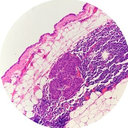Identification of an arabinopyranosyltransferase from Physcomitrella patens involved in the synthesis of the hemicellulose xyloglucan.
Palavras-chave
Resumo
The hemicellulose xyloglucan consists of a backbone of a β-1,4 glucan substituted with xylosyl moieties and many other, diverse side chains that are important for its proper function. Many, but not all glycosyltransferases involved in the biosynthesis of xyloglucan have been identified. Here, we report the identification of an hitherto elusive xyloglucan:arabinopyranosyltransferase. This glycosyltransferase was isolated from the moss Physcomitrella patens, where it acts as a xyloglucan "D"-side chain transferase (XDT). Heterologous expression of PpXDT in the Arabidopsis thaliana double mutant mur3.1 xlt2, where xyloglucan consists of a xylosylated glucan without further glycosyl substituents, results in the production of the arabinopyranose-containing "D" side chain as characterized by oligosaccharide mass profiling, glycosidic linkage analysis, and NMR analysis. In addition, expression of a related Physcomitrella glycosyltransferase ortholog of PpXLT2 leads to the production of the galactose-containing "L" side chain. The presence of the "D" and "L" xyloglucan side chains in the Arabidopsis double mutant Atmur3.1 xlt2 expressing PpXDT and PpXLT2, respectively, rescues the dwarfed phenotype of untransformed Atmur3.1 xlt2 mutants to nearly wild-type height. Expression of PpXDT and PpXLT2 in the Atmur3.1 xlt2 mutant also enhanced root growth.


